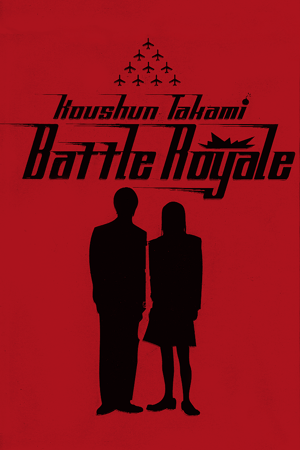 |
 |
Review by Shirley S Muramoto |
|

by Koushun Takami USA Release: Feb. 26, 2003 VIZ Media LLC PB ISBN: 978-1569317785 |
|||
The year is 1997, and it's just another ordinary day. There's a class of 42 junior high school kids – 21 boys, 21 girls – off on a special class trip. A bunch of girls are sitting around their teacher, being loud and boisterous. At the back, the thugs are sniggering over some probably off-color joke, while at the other end just behind the bus driver the most lovey-dovey couple in class sit together, eyes filled with nothing but each other. Nothing at all unusual.
Until, of course, the sleeping gas starts pumping in, and the entire class is quickly rendered unconscious.
When the students awake, they find themselves in a strange classroom, with strange metal collars around their necks, and a strange man with a grinning face tells them that they are all on a small isolated island …
…and that they will have to all kill each other until only one survives.
Welcome to the world of Battle Royale, a chilling novel by Koushun Takami. Originally written in Japanese, the story is set in a alternate-reality Japan, where the country is a fascist state isolated from the rest of the world. The people are closely controlled with ruthless efficiently, and any daring to express dissent are quickly silenced – forcibly and sometimes permanently. Raised in this repressive environment, the children find themselves unwilling subjects of what the government calls a "conscription system," necessary to "protect the nation" from the brainwashing manipulations of enemy nations, such as the American Imperialists.
So every few years, a number of third-year junior high school classes are randomly selected, kidnapped, taken to a remote location, and made to kill each other. Each student is given a pack containing a map, a pencil, a compass, a watch, a loaf of bread, a bottle of water, and a weapon. Each student is equipped with a collar around the neck, which not only monitors life signs and location (via a GPS system), but is also armed with enough explosives to render them a headless cadaver instantly. Attempting to remove the collar will make it explode. Getting caught in one of the "forbidden zones" (randomly selected by a computer at certain hours and announced three times a day) will cause the collar to explode. And if there is no death among them after a 24 hour period, all the collars worn by living students will explode.
Sent from the classroom one by one, the students struggle to survive against their classmates-turned-opponents in this macabre game. While some students cling stubbornly to the idea of trust and cooperation, others fall prey to fear and suspicion. And a few embrace the madness fully, giving their all to emerge as the singular survivor.
With the all the pieces in play, the game begins.
The story flips back and forth between different students, and is a strange balance between episodes of brutal violence and moments of thoughtful normality. The narrative is a bit difficult to follow at times. Sometimes the author extensively describes seemingly minor details in the middle of an action sequence, which tends to make things feel a bit choppy and interrupted. Whether this is intentional or happenstance, I'm not sure.
Further complicating matters is the fact that a few of the cultural references don't really have equivalent translations in English – like the use of honorifics like –kun or –san at the end of names. Add to this the differences in the literary conventions between the two cultures, and the difficulty to convey the original power of the story increases immensely. The translator does his best to bridge the gap, but the strain is often noticeable.
Still, even with all these difficulties, the story remains powerfully disturbing and thought provoking. The characters are engaging, capturing something of that innocent naiveté of youth, even as fear and suspicion threatens to drive them further and further down the path of inhumanity. The struggle presented here is on many levels – youthful idealism versus oppressive authority, freedom versus totalitarian control, self-interest versus cooperation, and perhaps most of all, trust versus fear.
Overall, it was truly worth the effort of reading through, despite any difficulties it has suffered through the translation process.
4 Bookwyrms.




This review copyright 2007 E.C.McMullen Jr.
| DRESS NICE | |
FEO AMANTE'S HORROR THRILLERCreated by:E.C.McMullen Jr. FOLLOW ME @ |
| Amazon |
| ECMJr |
| Feo Blog |
| IMDb |
| Stage32 |
| X |
| YouTube |
| Zazzle Shop |

